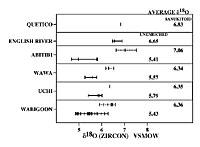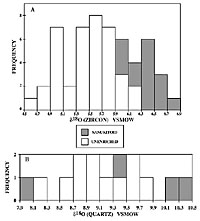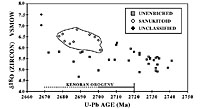Oxygen Isotope Ratios of Archean Plutonic Zircons From Granite-Greenstone Belts of the Superior Province
King, Elizabeth M., Valley, John W., Davis, Don W., Edwards, and Garth R., (1998) Oxygen isotope ratios of Archean plutonic zircons from granite-greenstone belts of the Superior Province: Indicator of magmatic source. Precambrian Research, v. 92, p. 365-387
Zircons commonly preserve primary magmatic oxygen isotope ratios even through high grade metamorphic events unlike quartz which more readily loses its primary d18O value by subsolidus exchange. Intrusive bodies from the Superior Province, Canada have an average d18O (Zircon) of 5.8± 0.6‰ (n=59 rocks); those from granite-greenstone belts have an average d18O (Zrc) =5.8±0.6‰ (n=55), in contrast to those from metasedimentary belts that average d18O (Zrc) 6.7±0.2‰ (n=4). The d18O zircon values from granite-greenstone belts indicate a maximum allowable input of 14% supracrustal, high d18O material into Archean magmas of the Superior Province relative to mantle d18O values.
Igneous bodies of the Superior Province have been separated into two groups based on geochemistry: unenriched plutons and sanukitoids. Magmatic oxygen isotope ratios inferred from these zircons indicate a subtle but significant division of less than 1‰ between the two geochemical sets of rocks. This distinction is apparent only in the d18O (Zrc) and not in more commonly analyzed, less refractory minerals such as quartz and feldspar.
Oxygen isotope data correlate with geochemical modeling of sanukitoids. The average d18O (Zrc) for sanukitoids is 6.4±0.2‰ in comparison to 5.5±0.4‰ for unenriched plutons. There is almost no overlap in values. The elevation of sanukitoid d18O(Zrc) indicates input from a high d18O source such as fluids from the subducting oceanic crust, melts of subducted sediments or continental crust.
All of the plutons analyzed in this study have been dated by U-Pb zircon techniques, and the combination of U-Pb ages and d18O (Zrc) indicates little variability of d18O vs. age during Archean plutonism in the Superior Province. Therefore, recycling of sediments and other high d18O sources was not a dominant process (no more than 6% increase) during crustal growth from 3003 to 2670 Ma in the Superior Province.


